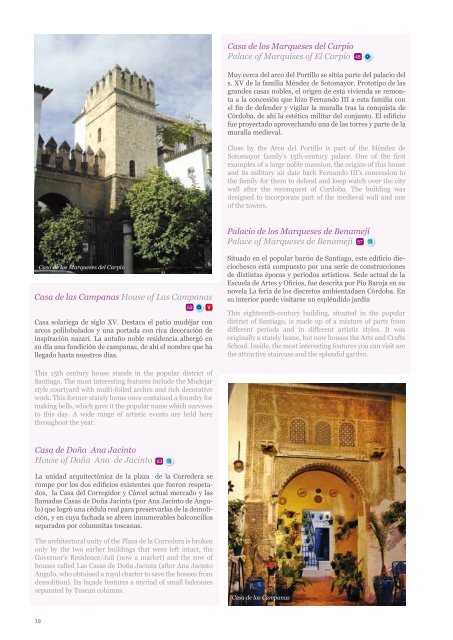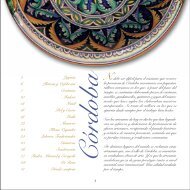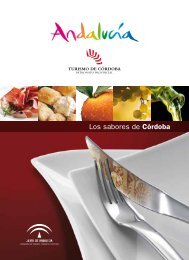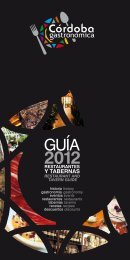You also want an ePaper? Increase the reach of your titles
YUMPU automatically turns print PDFs into web optimized ePapers that Google loves.
Casa de los Marqueses del Carpio<br />
Palace of Marquises of El Carpio<br />
Muy cerca del arco del Portillo se sitúa parte del palacio del<br />
s. XV de la familia Méndez de Sotomayor. Prototipo de las<br />
grandes casas nobles, el origen de esta vivienda se remonta<br />
a la concesión que hizo Fernando III a esta familia con<br />
el fin de defender y vigilar la muralla tras la conquista de<br />
Córdoba, de ahí la estética militar del conjunto. El edificio<br />
fue proyectado aprovechando una de las torres y parte de la<br />
muralla medieval.<br />
Close by the Arco del Portillo is part of the Méndez de<br />
Sotomayor family’s 15th-century palace. One of the first<br />
examples of a large noble mansion, the origins of this house<br />
and its military air date back Fernando III’s concession to<br />
the family for them to defend and keep watch over the city<br />
wall after the reconquest of Cordoba. The building was<br />
designed to incorporate part of the medieval wall and one<br />
of the towers.<br />
48<br />
Palacio de los Marqueses de Benamejí<br />
Palace of Marqueses de Benamejí 57<br />
Casa de los Marqueses del Carpio<br />
Casa de las Campanas House of Las Campanas<br />
53 V<br />
Casa solariega de siglo XV. Destaca el patio mudéjar con<br />
arcos polilobulados y una portada con rica decoración de<br />
inspiración nazarí. La antaño noble residencia albergó en<br />
su día una fundición de campanas, de ahí el nombre que ha<br />
llegado hasta nuestros días.<br />
Situado en el popular barrio de Santiago, este edificio dieciochesco<br />
está compuesto por una serie de construcciones<br />
de distintas épocas y periodos artísticos. Sede actual de la<br />
Escuela de Artes y Oficios, fue descrita por Pío Baroja en su<br />
novela La feria de los discretos ambientadaen Córdoba. En<br />
su interior puede visitarse un espléndido jardín<br />
This eighteenth-century building, situated in the popular<br />
district of Santiago, is made up of a mixture of parts from<br />
different periods and in different artistic styles. It was<br />
originally a stately home, but now houses the Arts and Crafts<br />
School. Inside, the most interesting features you can visit are<br />
the attractive staircase and the splendid garden.<br />
This 15th century house stands in the popular district of<br />
Santiago. The most interesting features include the Mudejar<br />
style courtyard with multi-foiled arches and rich decorative<br />
work. This former stately home once contained a foundry for<br />
making bells, which gave it the popular name which survives<br />
to this day. A wide range of artistic events are held here<br />
throughout the year.<br />
Casa de Doña Ana Jacinto<br />
House of Doña Ana de Jacinto<br />
La unidad arquitectónica de la plaza de la Corredera se<br />
rompe por los dos edificios existentes que fueron respetados,<br />
la Casa del Corregidor y Cárcel actual mercado y las<br />
llamadas Casas de Doña Jacinta (por Ana Jacinto de Angulo)<br />
que logró una cédula real para preservarlas de la demolición,<br />
y en cuya fachada se abren innumerables balconcillos<br />
separados por columnitas toscanas.<br />
63<br />
The architectural unity of the Plaza de la Corredera is broken<br />
only by the two earlier buildings that were left intact, the<br />
Governor’s Residence/Jail (now a market) and the row of<br />
houses called Las Casas de Doña Jacinta (after Ana Jacinto<br />
Angulo, who obtained a royal charter to save the houses from<br />
demolition). Its façade features a myriad of small balconies<br />
separated by Tuscan columns.<br />
Casa de las Campanas<br />
38







